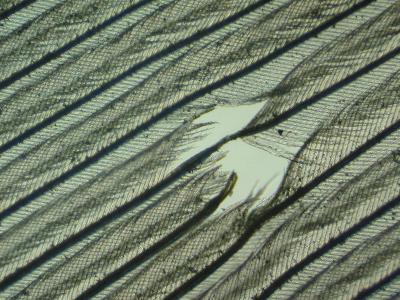Feather Hole on:
[Wikipedia]
[Google]
[Amazon]
 Feather holes often characteristically occur on wing and tail
Feather holes often characteristically occur on wing and tail
 Feather holes often characteristically occur on wing and tail
Feather holes often characteristically occur on wing and tail feather
Feathers are epidermal growths that form a distinctive outer covering, or plumage, on both avian (bird) and some non-avian dinosaurs and other archosaurs. They are the most complex integumentary structures found in vertebrates and a premier ...
s of some small-bodied species of passerines. In the case of barn swallows, it was suggested that the holes were feeding traces of avian lice
Louse ( : lice) is the common name for any member of the clade Phthiraptera, which contains nearly 5,000 species of wingless parasitic insects. Phthiraptera has variously been recognized as an order, infraorder, or a parvorder, as a result o ...
, either ''Machaerilaemus malleus
''Machaerilaemus malleus'' is a species of louse belonging to the family Menoponidae
Menoponidae is a monophyletic family of lice in the superfamily of chewing lice, Amblycera, often referred to as the chicken body louse family. They are ...
'' and/or ''Myrsidea rustica
''Machaerilaemus malleus'' is a species of louse belonging to the family Menoponidae
Menoponidae is a monophyletic family of lice in the superfamily of chewing lice, Amblycera, often referred to as the chicken body louse family. They are ...
'' (both Phthiraptera: Amblycera
The Amblycera are a large clade of chewing lice,
parasitic on both birds and mammals. The Amblycera are considered the most primitive clade of lice.
Description
These insects are very much like the familiar advanced sucking lice, except they ...
).
Hole counts were shown to be highly repeatable, and thus counts appeared to be useful measures to quantify the intensity of infestation. Since then, a number of influential papers have been published on the evolutionary, ecological, and behavioral aspects of host-parasite interactions based on the assumption that holes were chewed by ''Machaerilaemus malleus''. More specifically, host sexual selection, feather breakage, flight performance, immunity levels, arrival dates, and even song characteristics were shown to covary with the number of holes. Cross-fostering experiments showed that infestation levels were heritable.
Recently, however, it was shown that ''Machaerilaemus malleus'' is apparently absent from Europe, where all these studies were carried out. Correlational evidence supports the hypothesis that feather holes are feeding traces of lice, however, the occurrence of ''Brueelia
''Brueelia'' (formerly spelled ''Brüelia'') is a genus of lice in the family Philopteridae, containing the following species:
* '' Brueelia amandavae'' Rekasi & Saxena, 2005
* '' Brueelia astrildae'' Tendeiro & Mendes, 1994
* '' Bureelia can ...
'' spp. lice ( Phthiraptera: Ischnocera
The Ischnocera is a large superfamily of lice. They are mostly parasitic on birds, but including a large family (the Trichodectidae) parasitic on mammals. The genus '' Trichophilopterus'' is also found on mammals (lemurs), but probably belongs ...
) provides the best fit to the distribution and abundance of feather holes both in barn swallows and across several small passerines.
References
{{DEFAULTSORT:Feather Holes Feathers Parasites of birds Lice